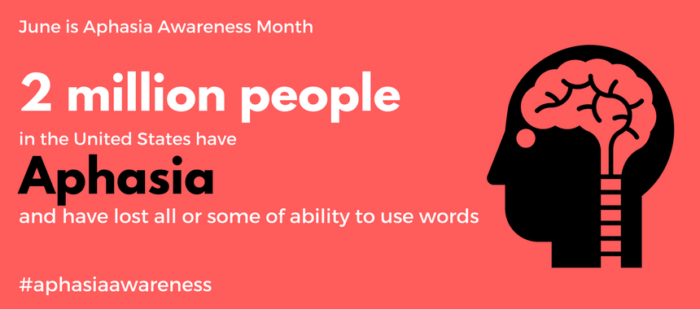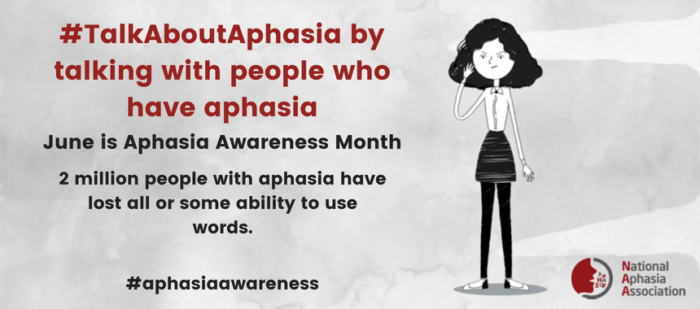
Two million people in the United States have lost some or all of their ability to use words. This impairment of language is called aphasia and it can affect the production or comprehension of speech and the ability to read or write. Aphasia is due to an injury to the brain and is most commonly from a stroke, but may also be from head trauma, brain tumors, or from infections. How severe someone’s aphasia may be is dependent on the cause and extent of the brain damage.
Symptoms of Aphasia:
- Speaking in incomplete sentences
- Speaking in sentences that don’t make sense
- Struggling with finding appropriate words
- Using inappropriate or strange words in a conversation
- Speaking unrecognizable words
- Not understanding conversation
- Writing sentences that don’t make sense
3 types of Aphasia:
- Comprehensive aphasia is also known as non-fluent aphasia. People who have comprehensive aphasia struggle to get words out, usually speak in short sentences, and omit words. They may understand what people are saying better than they are able to speak.
- Expressive aphasia is also known as fluent aphasia. People who have expressive aphasia can speak easily and fluently using long and complex sentence, but they might not make sense or include incorrect or unrecognizable words. They usually don’t realize that other people cannot understand them and often don’t understand spoken language.
- Global aphasia is both poor comprehension and difficulty producing words. People with global aphasia have severe disabilities with both expression and comprehension of language.
The inability to communicate can cause many problems in a person’s everyday life. Difficulty communicating may affect a person’s job, their relationships, and day-to-day activities. People with aphasia often feel embarrassed about their difficulties and can become depressed or have difficulties in their relationships.
The main treatment for aphasia is Speech and Language therapy and the treatment used is to relearn language skills or learn other ways to communicate. Learning to communicate without speech is called augmentative or alternative communication (AAC). AAC can be tools, systems, devices, or strategies to help a person communicate when they are unable to rely on speech. AAC is broken up into two groups, which are unaided AAC and aided AAC.
Unaided AAC
- Facial expressions
- Body language
- Gestures
- Sign Language
Aided AAC
- Symbol boards
- Choice cards
- Communication books
- Speech-generating/communication devices
- AAC apps on mobile devices
Aided AAC devices can be text-based. These text-based AAC’s are used for people who are familiar with written language. There are also symbol-based aided AAC devices that use symbols and pictures for individuals who cannot read or spell.
Communication is a vital and fundamental human right and AAC devices allow an individual who is not able to speak verbally to communicate with others. Many AAC users indicate that before having a device to communicate they often felt isolated, frustrated, and vulnerable.
June is Aphasia Awareness Month and according to aphasia.org 84.5% of Americans have never heard the term aphasia. They National Aphasia Association is currently running a campaign to help spread the word about aphasia and create awareness.
Here is a helpful video they put together to spread awareness:
Resources available for individuals with aphasia and their caregivers:
- National Aphasia Association (NAA): NAA is a non-profit organization dedicating to providing “access to research, education, rehabilitation, therapeutic and advocacy services to individuals with aphasia and their caregivers.” Click here to learn more about their resources.
- ASHA: AAC devices and communication apps are also categorized as assistive technology, which includes any piece of equipment or system that increases the independence of an individual with a disability. There are many communication devices and apps available for individuals who have difficulty with communication. The American Speech-Language-Hearing Association (AHSA) has many resources to learn more about aided and unaided resources available. Click here to learn more about those resources.
- BridgingApps: BridgingApps is a program of Easter Seals Greater Houston that provides tools to find education and therapeutic apps for people with disabilities and they have created a great tool to search for communication apps: Click here to utilize their app finder.
- INDATA Project Equipment Loan Library: One of the main goals of the INDATA Project is to increase access to assistive technology such as augmentative communication devices. We do this through our equipment loan library, which is an equipment loan program where assistive technology can be borrowed by anyone who lives in the state of Indiana for free for 30 days. The loan library has over 2000 devices included augmentative communication devices and iPads/tablets with communication apps. Click here to learn more about the library and to search assistive technology devices available for loan.
- INDATA Project Blogs: The INDATA Project produces 3 assistive technology blogs a week. Although the topics are varied and written for all types of disabilities, often blogs are highlighting AAC devices and apps such as this one on communication apps: https://www.eastersealstech.com/2011/04/13/augmentative-and-alternative-communication-apps/
- INDATA Project Tech Tips: Our weekly tech tips highlight many different assistive technology devices include augmentative communication devices and communication apps. Click here to learn more about our YouTube channel and see many of the tech tips we have done. https://www.youtube.com/user/indataprojectESC/search?view_as=subscriber&query=communication+apps

Above are just a few resources available to learn more about #aphasiaawareness and aphasi.org welcomes everyone to help them spread the word about aphasia. They have asked everyone to #TalkAboutAphasia on social media platforms. Click here to learn more ways to help them spread the word so together we can all increase more understanding about people with aphasia and the resources available to increase independence for those with aphasia.
